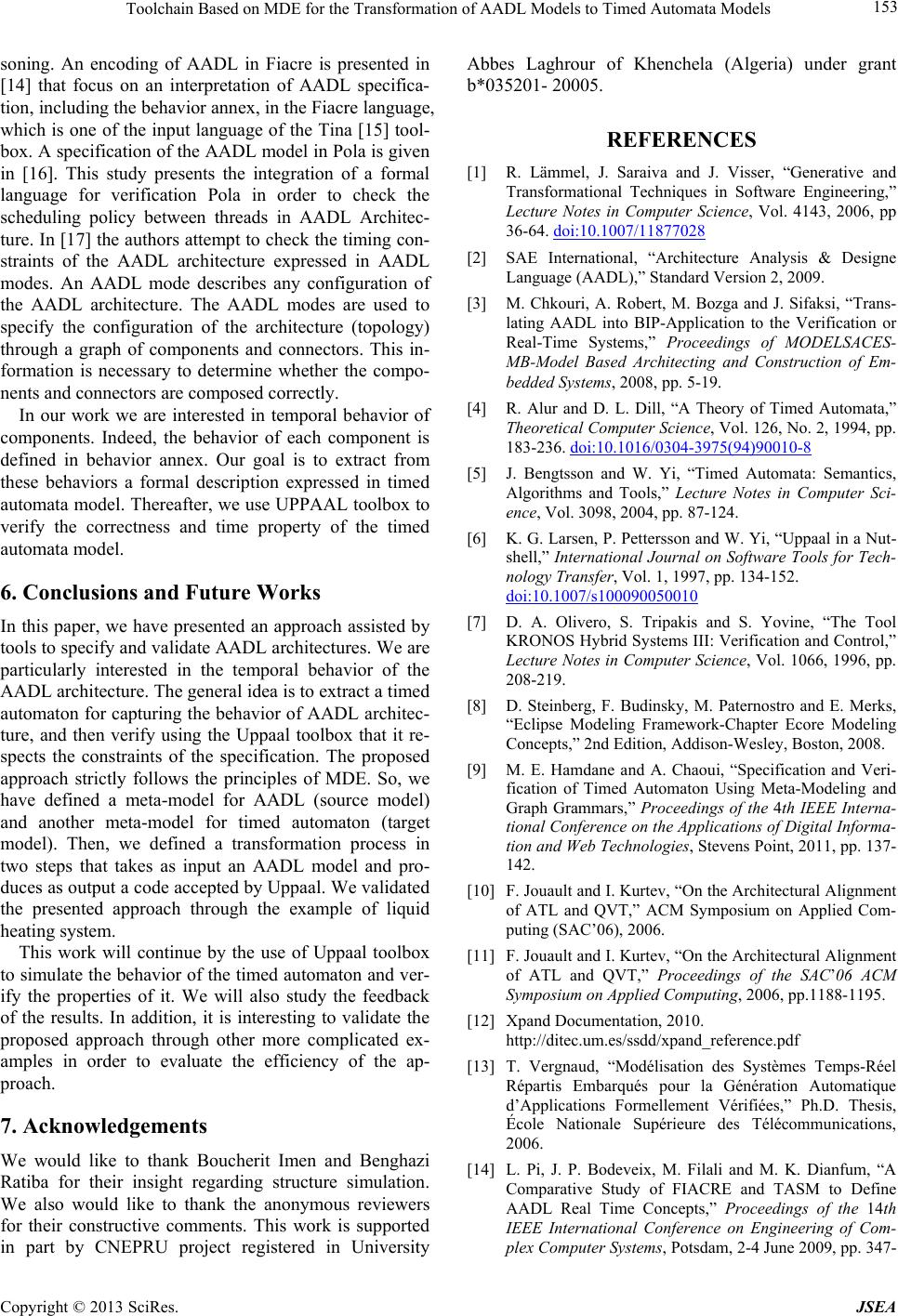
Toolchain Based on MDE for the Transformation of AADL Models to Timed Automata Models 153
soning. An encoding of AADL in Fiacre is presented in
[14] that focus on an interpretation of AADL specifica-
tion, including the behavior annex, in the Fiacre language,
which is one of the input language of the Tina [15] tool-
box. A specification of the AADL model in Pola is given
in [16]. This study presents the integration of a formal
language for verification Pola in order to check the
scheduling policy between threads in AADL Architec-
ture. In [17] the authors attempt to check the timing con-
straints of the AADL architecture expressed in AADL
modes. An AADL mode describes any configuration of
the AADL architecture. The AADL modes are used to
specify the configuration of the architecture (topology)
through a graph of components and connectors. This in-
formation is necessary to determine whether the compo-
nents and connectors are composed correctly.
In our work we are interested in temporal behavior of
components. Indeed, the behavior of each component is
defined in behavior annex. Our goal is to extract from
these behaviors a formal description expressed in timed
automata model. Thereafter, we use UPPAAL toolbox to
verify the correctness and time property of the timed
automata model.
6. Conclusions and Future Works
In this paper, we have presented an approach assisted by
tools to specify and validate AADL architectures. We are
particularly interested in the temporal behavior of the
AADL architecture. The general idea is to extract a timed
automaton for capturing the behavior of AADL architec-
ture, and then verify using the Uppaal toolbox that it re-
spects the constraints of the specification. The proposed
approach strictly follows the principles of MDE. So, we
have defined a meta-model for AADL (source model)
and another meta-model for timed automaton (target
model). Then, we defined a transformation process in
two steps that takes as input an AADL model and pro-
duces as output a code accepted by Uppaal. We validated
the presented approach through the example of liquid
heating system.
This work will continue by the use of Uppaal toolbox
to simulate the behavior of the timed automaton and ver-
ify the properties of it. We will also study the feedback
of the results. In addition, it is interesting to validate the
proposed approach through other more complicated ex-
amples in order to evaluate the efficiency of the ap-
proach.
7. Acknowledgements
We would like to thank Boucherit Imen and Benghazi
Ratiba for their insight regarding structure simulation.
We also would like to thank the anonymous reviewers
for their constructive comments. This work is supported
in part by CNEPRU project registered in University
Abbes Laghrour of Khenchela (Algeria) under grant
b*035201- 20005.
REFERENCES
[1] R. Lämmel, J. Saraiva and J. Visser, “Generative and
Transformational Techniques in Software Engineering,”
Lecture Notes in Computer Science, Vol. 4143, 2006, pp
36-64. doi:10.1007/11877028
[2] SAE International, “Architecture Analysis & Designe
Language (AADL),” Standard Version 2, 2009.
[3] M. Chkouri, A. Robert, M. Bozga and J. Sifaksi, “Trans-
lating AADL into BIP-Application to the Verification or
Real-Time Systems,” Proceedings of MODELSACES-
MB-Model Based Architecting and Construction of Em-
bedded Systems, 2008, pp. 5-19.
[4] R. Alur and D. L. Dill, “A Theory of Timed Automata,”
Theoretical Computer Science, Vol. 126, No. 2, 1994, pp.
183-236. doi:10.1016/0304-3975(94)90010-8
[5] J. Bengtsson and W. Yi, “Timed Automata: Semantics,
Algorithms and Tools,” Lecture Notes in Computer Sci-
ence, Vol. 3098, 2004, pp. 87-124.
[6] K. G. Larsen, P. Pettersson and W. Yi, “Uppaal in a Nut-
shell,” International Journal on Software Tools for Tech-
nology Transfer, Vol. 1, 1997, pp. 134-152.
doi:10.1007/s100090050010
[7] D. A. Olivero, S. Tripakis and S. Yovine, “The Tool
KRONOS Hybrid Systems III: Verification and Control,”
Lecture Notes in Computer Science, Vol. 1066, 1996, pp.
208-219.
[8] D. Steinberg, F. Budinsky, M. Paternostro and E. Merks,
“Eclipse Modeling Framework-Chapter Ecore Modeling
Concepts,” 2nd Edition, Addison-Wesley, Boston, 2008.
[9] M. E. Hamdane and A. Chaoui, “Specification and Veri-
fication of Timed Automaton Using Meta-Modeling and
Graph Grammars,” Proceedings of the 4th IEEE Interna-
tional Conference on the Applications of Digital Informa-
tion and Web Technologies, Stevens Point, 2011, pp. 137-
142.
[10] F. Jouault and I. Kurtev, “On the Architectural Alignment
of ATL and QVT,” ACM Symposium on Applied Com-
puting (SAC’06), 2006.
[11] F. Jouault and I. Kurtev, “On the Architectural Alignment
of ATL and QVT,” Proceedings of the SAC’06 ACM
Symposium on Applied Computing, 2006, pp.1188-1195.
[12] Xpand Documentation, 2010.
http://ditec.um.es/ssdd/xpand_reference.pdf
[13] T. Vergnaud, “Modélisation des Systèmes Temps-Réel
Répartis Embarqués pour la Génération Automatique
d’Applications Formellement Vérifiées,” Ph.D. Thesis,
École Nationale Supérieure des Télécommunications,
2006.
[14] L. Pi, J. P. Bodeveix, M. Filali and M. K. Dianfum, “A
Comparative Study of FIACRE and TASM to Define
AADL Real Time Concepts,” Proceedings of the 14th
IEEE International Conference on Engineering of Com-
plex Computer Systems, Potsdam, 2-4 June 2009, pp. 347-
Copyright © 2013 SciRes. JSEA